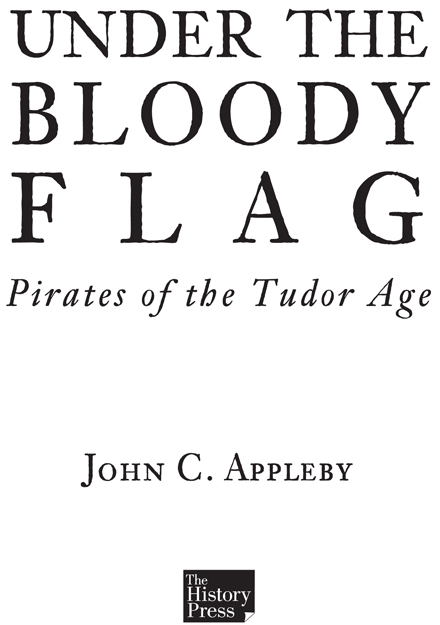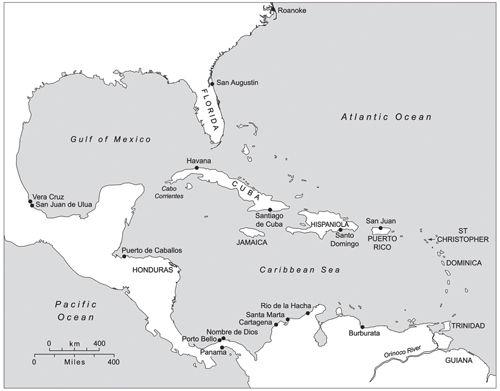Under the Bloody Flag
Read Under the Bloody Flag Online
Authors: John C Appleby



Many thanks to Jonathan Reeve of The History Press for commissioning the book, to Simon Hamlet and Robin Harries for seeing it through to publication, and to Sandra Mather of the University of Liverpool for preparing the maps with such skill. Although this work draws on my own research among the records of the High Court of the Admiralty in The National Archives at Kew, which was originally undertaken under the supervision of Professsor Kenneth Andrews, it makes extensive use of the contributions of other scholars. In particular, I would like to acknowledge my debt to the works of K.R. Andrews, D. Loades, D.B. Quinn and N.A.M. Rodger on maritime and naval history, and the works of Peter Earle and Marcus Rediker on the history of piracy. In addition, I thank the staff of The National Archives and The British Library for their assistance, and the archivists of local record offices who responded promptly to my enquiries.
1
War and Maritime Plunder from the 1480s to the 1540s
2
Pirates and Rebellious Rovers during the 1540s and 1550s
3
Pirates, Privateers and Slave Traders from the later 1550s to the later 1560s
4
Piracy, Plunder and Undeclared War during the 1570s
5
The Profession of Piracy from the mid-1570s to 1585
6
War, Reprisals and Piracy from 1585 to 1603

Map 1: Southern England, Wales and Ireland.

Map 2: The Spanish Caribbean.

Map 3: Eastern England and the North Sea.

Map 4: Spain, Portugal and the Mediterranean.
By the later Middle Ages maritime depredation was a long-standing and widespread problem. The voyages of traders and fishermen were threatened by sea robbers of varying description, though the intensity of activity ebbed and flowed like the seas on which they sailed. At times, the prevalence of such predators contributed to a deep-seated aversion of the sea, particularly as an unsettling and unknowable place of danger and chaos.
1
Yet maritime robbery and spoil assumed varied forms. Although legal definitions were blurred by practice, which at times eroded the boundary between trade and plunder, a distinction can be drawn between piracy, reprisal venturing and privateering, and corsair enterprise. Piracy had a protean and prosaic quality, enabling it to develop and flourish almost unchecked. In theory, pirates were criminals, the enemies of all mankind who faced execution if caught; in practice, they were often maintained by seafaring communities and protected by local officials or rulers. Within some regions piracy flourished as a community crime. Organized as a small-scale business, it provided employment and profit, while serving as an outlet for adventurous or violent men and boys. Ports and havens along the south coast of England, including Rye, Fowey or Dartmouth, acquired notorious reputations as nests of pirates who plundered unwary shipping in the Channel. According to the law and custom of the sea, reprisal venturing and what was later to be known as privateering were distinguished from piracy by their legal character and status. Although a clear distinction was to emerge between these lawful forms of seaborne plunder, acknowledged in the separate use of letters of reprisal and letters of marque, both were hopelessly confused during the sixteenth and early seventeenth centuries. Authorizing reprisals was a widely accepted means of allowing merchants and shipowners to recover losses from the subjects of a foreign state, and it was subject to strict control and regulation. During times of war, however, when reprisal venturing was encouraged for strategic and economic purposes, through the indiscriminate issue of commissions, it assumed the characteristics of privateering. As a form of war it might be compared with the tradition of corsair activity within the Mediterranean, though this encompassed plunder, brigandage and slave raiding.
2
There was, of course, a degree of overlap between these different forms of plunder and spoil. Recruits from various backgrounds, including a large number of seafarers, served aboard pirate and reprisal vessels. The companies of some ships might resort to piratical spoil and lawful plunder during the course of the same voyage. While the law did not recognize the nuances of such fractured voyages or life cycles, they were overtly acknowledged in the language of seamen, notably in the widespread use of the term ‘sea roving’ to describe an enterprise which seemed to fall between piracy and privateering. Whether justified as a means of unauthorized retaliation or reprisals, sea roving represented blurred boundaries at sea, reflecting the way in which piracy was also a contested crime, thriving on ambiguity and uncertainty.
The difficulty in maintaining the distinction between lawful and unlawful depredation was a direct consequence of the nature of the early modern state and of sea power in general. In the absence of professional navies, and with small royal fleets made up of ships which could still be challenged by well-armed private vessels, maritime power was essentially fragmented. In addition it was marked by an inescapable intermingling of public and private interests. Under these conditions it has been argued that ‘private, commercial warfare was the normal form of warfare in the open sea’.
3
In England during the fourteenth and fifteenth centuries it became common practice for monarchs to sanction what were effectively private wars of reprisal, unintentionally encouraging the spread of disorder and lawlessness at sea. While this expedient mobilized and exploited private resources, it also drew on a shadowy tradition of piracy and piratical enterprise which persisted throughout the sixteenth and early seventeenth centuries. It allowed arch-pirates, such as Henry Strangeways or John Callice, to redeem their misdeeds through royal service at sea, and enabled more renowned pirate leaders, like Francis Drake or Martin Frobisher, to serve as officers in the Queen’s Navy. It is no coincidence that the development of an effective state navy during the second half of the seventeenth century was followed by a sustained, and largely successful, effort to eradicate organized piracy.
4
Past experience demonstrated that piracy and other forms of irregular depredation flourished at times of weak rule or in remote regions. In south-west England it may have served as a safety valve for aristocratic and gentry disorder or violence, which successive monarchs found difficult to contain. Within a distant, maritime borderland, however, resorting to piracy was almost a way of life, especially for itinerant seafarers subject to occasional and disjointed patterns of employment. Favoured by geography and well-established commercial links, pirates and sea rovers from the south-west ranged across the Channel and into the Irish Sea, disposing of their booty in favoured haunts which served as unofficial markets and provisioning centres. The importance of Ireland to the maintenance of this pattern of venturing was recognized in 1521 by Henry VIII’s lieutenant in Dublin. In the face of a growing problem, he requested a commission ‘to put to death all rovers of the sea taken in this land’, warning that Ireland was ‘the very land of refuge that English pirates most resort unto’.
5
Piracy and other forms of depredation flourished throughout the sixteenth century. As a result, the Tudor regime was faced with an intractable problem which grew progressively worse. To some extent this was self-inflicted, particularly given the apparent decline in lawlessness at sea during the 1480s and 1490s. Thereafter war bred piracy and maritime disorder. Conditions at sea were reinforced by the unsettling consequences of social and economic change, including population growth, which were increasingly influenced by religious rivalries and hostility. But the growth of disorderly plunder merged with aggressive commercial ambitions and ventures, especially in new, long-distance enterprises to west Africa and America. The competition with Spain and Portugal which accompanied such schemes helped to re-direct and re-structure piracy and privateering, opening up profitable opportunities which were eagerly seized by Drake and his successors.
